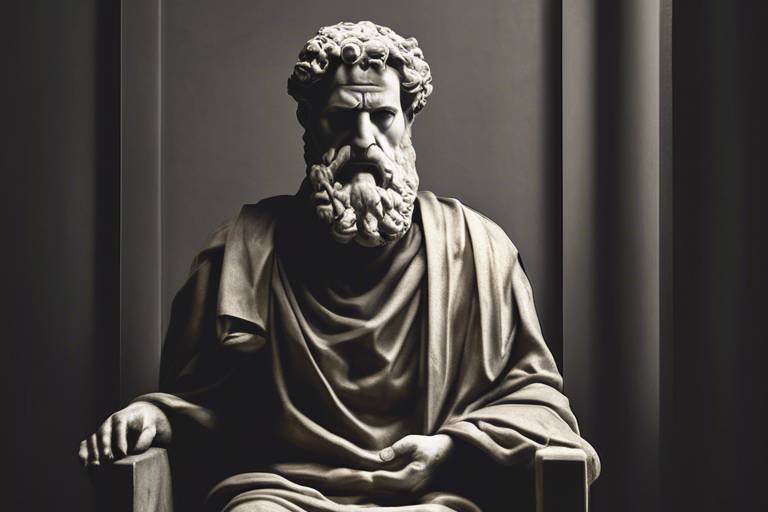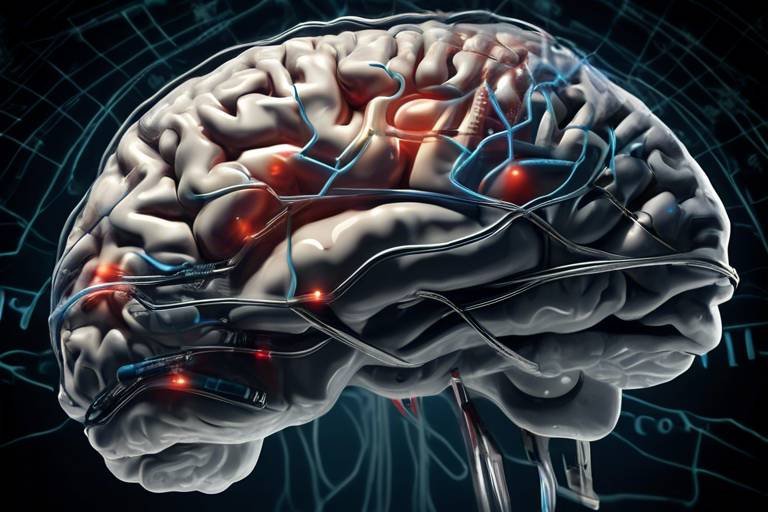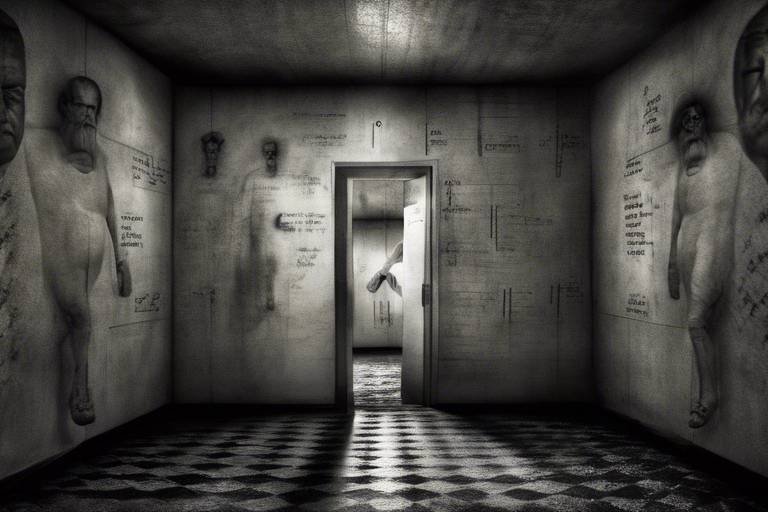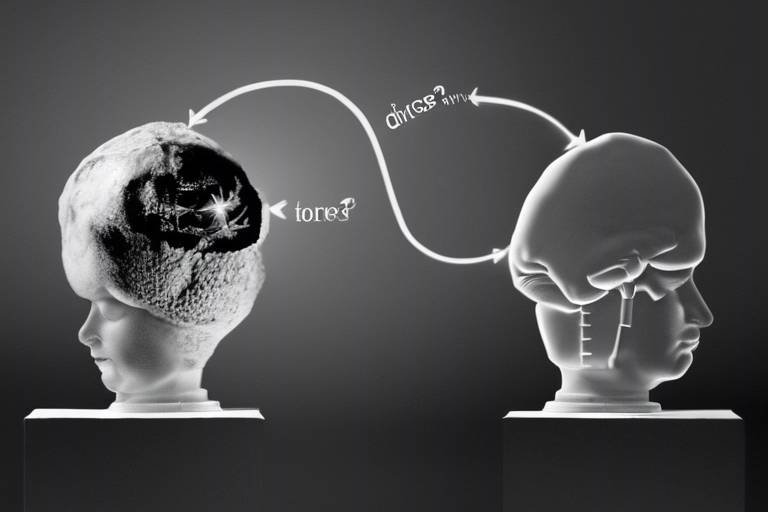Plato's Allegory of the Cave According to Modern Science
Have you ever felt like you were merely observing shadows on a wall, unaware of the vibrant reality beyond your immediate perception? This feeling resonates deeply with Plato's Allegory of the Cave, a philosophical metaphor that has transcended time and continues to find relevance in our modern scientific explorations. In this article, we will delve into how this ancient allegory aligns with contemporary thoughts on perception, reality, and the relentless pursuit of knowledge. Just as the prisoners in the cave are confined to seeing only shadows, we too may find ourselves trapped in our limited understanding of the world. So, let's embark on this enlightening journey together!
Plato's Allegory of the Cave is not just a story; it's a profound commentary on human existence. Imagine a group of prisoners who have been chained inside a dark cave for their entire lives, facing a blank wall. Behind them, there is a fire, and between the fire and the prisoners, puppeteers cast shadows on the wall. These shadows represent the prisoners' only reality, and they are completely unaware that there is a world outside the cave filled with color, depth, and life. When one prisoner escapes and discovers the true world, he realizes that the shadows were mere illusions. This allegory raises essential questions about knowledge and belief: What is reality? How do we know what we know? These questions remain relevant today, as we navigate a world filled with information and misinformation.
Fast forward to the present, and we find that many thinkers and scientists have drawn parallels between Plato's cave and our modern lives. The allegory serves as a lens through which we can examine our understanding of reality. For instance, in the realm of psychology, the way we perceive the world is often influenced by our experiences, much like the prisoners who only understand their reality through the shadows. Our perceptions can be distorted by cognitive biases, leading us to believe in a reality that may not truly exist.
In the field of psychology, the concept of perception is crucial. Just as the prisoners in the cave are limited by their view, our understanding of reality is shaped by our experiences and the information we consume. For example, have you ever noticed how two people can witness the same event yet recount it entirely differently? This discrepancy highlights the subjective nature of perception. Our brains are wired to interpret information based on previous experiences, beliefs, and even emotions. This means that our reality is not just a reflection of the external world, but a complex tapestry woven from our individual experiences.
Cognitive biases play a significant role in shaping our perceptions, acting as filters that can distort our understanding of truth. These biases can be compared to the shadows on the cave wall, where we may see only what we want to see, rather than the complete picture. Some common cognitive biases include:
- Confirmation Bias: The tendency to search for, interpret, and remember information that confirms our preexisting beliefs.
- Anchoring Bias: Relying too heavily on the first piece of information encountered when making decisions.
- Availability Heuristic: Overestimating the importance of information readily available to us.
Understanding these biases is crucial for anyone seeking to unveil the truth hidden behind the shadows.
Neuroscience provides fascinating insights into how our brains process information, offering a deeper understanding of perception. Research shows that our brains are constantly filtering and interpreting sensory data, creating a version of reality that may differ from the actual world. This aligns perfectly with Plato's allegory, as the prisoners are unaware of the true forms outside their cave. Our neural pathways are shaped by our experiences, which means that each person’s perception of reality is unique. As we unravel the complexities of the brain, we come to realize that our understanding of reality is not just a passive observation but an active construction influenced by many factors.
In the scientific realm, paradigms can be likened to the cave itself. Just as the prisoners accept the shadows as reality, scientists often work within established frameworks that can obscure deeper truths. Revolutionary ideas sometimes face resistance because they challenge the prevailing theories. This situation is reminiscent of the escaped prisoner who returns to the cave to share his newfound knowledge, only to be met with skepticism. The evolution of scientific thought often requires breaking free from these paradigms to uncover new understandings of the universe.
As we step into an era dominated by technology, the lines between reality and illusion continue to blur. With advancements in virtual reality, we find ourselves exploring new dimensions of experience that challenge our understanding of what is real. This phenomenon parallels the cave metaphor, where our perceptions are limited by the tools we use to engage with the world.
Virtual reality (VR) immerses users in simulated environments, creating experiences that can feel incredibly real. Just as the prisoners in the cave are confined to their limited view, VR users may struggle to distinguish between the virtual and the actual world. This raises profound questions: What happens to our understanding of reality when we can create and manipulate it at will? As we navigate these digital landscapes, we must remain vigilant about the impact they have on our perceptions.
Social media also plays a significant role in shaping our perceptions of reality. These platforms often serve as modern-day shadows on the cave wall, distorting the truth and presenting curated versions of life. The information we consume on social media can influence our beliefs and attitudes, creating echo chambers where only certain viewpoints are amplified. This phenomenon emphasizes the importance of critical thinking and the pursuit of truth beyond appearances.
In a world filled with distractions and illusions, the search for truth becomes more vital than ever. Just like the escaped prisoner who seeks to enlighten others, we must embark on our own journeys toward understanding. This journey requires us to question our assumptions, challenge our biases, and seek knowledge beyond the shadows. As we navigate this complex world, let us reflect on our own experiences and strive for enlightenment in our pursuit of truth.
- What is the main message of Plato's Allegory of the Cave? The allegory illustrates the difference between the world of appearances and the world of reality, emphasizing the importance of seeking knowledge beyond superficial understanding.
- How does modern science relate to the allegory? Modern science explores concepts of perception, cognitive biases, and the influence of technology, paralleling the themes of the allegory.
- Why is understanding cognitive biases important? Recognizing cognitive biases helps individuals make more informed decisions and develop a clearer understanding of reality.

The Allegory Explained
Plato's Allegory of the Cave is a profound philosophical metaphor that has captivated thinkers for centuries. Imagine a dark cave where prisoners are chained, unable to turn their heads. They can only see the wall in front of them, upon which shadows are cast by objects passing in front of a fire behind them. These shadows represent the only reality the prisoners know. For them, the shadows are the entirety of existence, and they believe them to be the true form of reality. This allegory serves as a powerful illustration of how humans often mistake perception for reality, raising critical questions about knowledge, belief, and enlightenment.
The prisoners in the cave symbolize individuals who are confined to their limited understanding of the world. When one prisoner breaks free and ventures outside, he is initially blinded by the sunlight, struggling to comprehend the vibrant world beyond the cave. This journey represents the philosophical quest for knowledge and truth. As he acclimatizes to the light, he realizes that the shadows were mere illusions, and he begins to understand the deeper reality of existence. This transformation is not just enlightening; it is also a painful process, as the freed prisoner grapples with the truth that those still in the cave cannot comprehend.
Plato's allegory profoundly impacts our understanding of knowledge, suggesting that enlightenment is a gradual process. It challenges us to question our own beliefs and perceptions. Are we, too, prisoners in our own caves, only seeing shadows of the truth? The allegory invites us to explore the nature of reality and encourages a relentless pursuit of knowledge, urging us to step outside the confines of our own limitations.
In contemporary discussions, this allegory resonates with various fields, including psychology, neuroscience, and even modern technology. It prompts us to consider how our perceptions are shaped by external influences and internal biases. The shadows on the wall can be likened to the misinformation and distorted realities we encounter in today’s world, whether through media, social networks, or personal experiences. Thus, the allegory remains relevant, challenging us to seek clarity and understanding in a complex and often confusing landscape.
To further illustrate the key elements of Plato's Allegory of the Cave, consider the following table:
| Element | Description |
|---|---|
| Prisoners | Individuals limited to their perceptions, unaware of the larger reality. |
| Shadows | Illusions or false realities that represent a distorted understanding of truth. |
| Fire | Source of light that creates the shadows, symbolizing limited knowledge. |
| Journey Outside | Process of enlightenment and the pursuit of true knowledge. |
| Sun | Represents ultimate truth and knowledge, illuminating the reality beyond the cave. |
Ultimately, Plato's Allegory of the Cave serves as a timeless reminder of the importance of questioning our perceptions and seeking deeper truths. It challenges us to recognize the limitations of our own understanding and inspires us to embark on our own journeys toward enlightenment.
- What is the main message of Plato's Allegory of the Cave? The main message is that reality is often obscured by our perceptions, and true knowledge requires us to question and seek beyond our immediate experiences.
- How does the allegory relate to modern science? The allegory parallels modern scientific pursuits, where prevailing theories can limit our understanding and where new discoveries challenge existing beliefs.
- Can we apply the allegory to our daily lives? Absolutely! It encourages critical thinking and self-reflection, prompting us to examine our beliefs and the sources of our information.

Modern Interpretations
When we think about Plato's Allegory of the Cave, we're often drawn into a world of shadows and light, where the distinction between reality and illusion becomes a central theme. But what does this allegory mean in today's context? Modern thinkers and scientists have taken Plato's ideas and woven them into the fabric of contemporary philosophy and science. They explore how our understanding of truth, reality, and knowledge can be obscured by the "caves" we inhabit—whether they are societal norms, scientific paradigms, or even personal beliefs.
One of the most fascinating aspects of modern interpretations of the Allegory is how it resonates with the challenges we face in our daily lives. For instance, renowned philosophers and psychologists have suggested that the shadows on the wall represent not just ignorance, but the myriad of perspectives that shape our understanding of the world. In essence, each individual's "cave" is unique, influenced by culture, education, and personal experiences. This brings us to the question: how do we break free from these confines to grasp a more profound truth?
In the realm of psychology, figures such as Carl Jung have emphasized the importance of self-awareness and introspection, which can be likened to stepping out of the cave. Jung's concept of the "collective unconscious" suggests that while we may perceive the world through our individual lenses, there exists a deeper, shared understanding that unites humanity. This idea echoes Plato's notion of enlightenment, where one must seek knowledge beyond the shadows to achieve true understanding.
Moreover, scientists like Thomas Kuhn have examined the role of paradigms in shaping scientific inquiry. Kuhn argued that scientific progress is not linear but rather occurs through revolutionary shifts, where one paradigm replaces another. This is akin to the prisoners in the cave experiencing a radical shift in their understanding once they are exposed to the outside world. The implications are profound: just as the prisoners had to confront the uncomfortable reality outside the cave, scientists must also challenge established beliefs to uncover deeper truths.
Additionally, the rise of technology has introduced new dimensions to our understanding of the Allegory. Virtual reality (VR) and augmented reality (AR) create immersive experiences that can blur the lines between what is real and what is simulated. These technologies serve as modern-day caves, where users can become entrapped in artificial environments, potentially losing sight of the truth that lies beyond. The question then arises: as we immerse ourselves in these digital realms, are we merely watching shadows dance on the walls, or are we actively engaging with a new reality?
In conclusion, modern interpretations of Plato's Allegory of the Cave challenge us to reflect on our own perceptions of reality. They urge us to question the shadows that dominate our lives and to seek enlightenment beyond the confines of our individual caves. Whether through the lens of psychology, science, or technology, the pursuit of truth remains a timeless endeavor, one that invites us to step out of the darkness and into the light.

Psychology and Perception
When we dive into the realm of , we find ourselves standing at the crossroads of how we interpret the world around us. Think about it: every day, we are bombarded with information, yet our brains filter this data, shaping our understanding of reality. This phenomenon mirrors Plato's prisoners in the cave, who only see shadows of the true forms. Just as those prisoners were limited in their perspective, our perceptions are often confined by our experiences, biases, and the context in which we find ourselves.
Our perception of reality is not merely a passive reflection of the world; it is an active construction influenced by various psychological factors. For instance, consider how two people can witness the same event yet describe it in completely different ways. This discrepancy arises from individual backgrounds, emotions, and cognitive frameworks. It’s like watching a movie with a friend—while you might be captivated by the cinematography, they might be fixated on the storyline, leading to entirely different interpretations of the same film.
One significant aspect of this psychological framework is the concept of cognitive biases. These are systematic patterns of deviation from norm or rationality in judgment. They affect how we gather, interpret, and recall information, ultimately influencing our perceptions of reality. For example, the confirmation bias leads individuals to favor information that confirms their preexisting beliefs, much like the prisoners in the cave who only recognized the shadows they were accustomed to. This bias can create a distorted view of reality, where one becomes trapped in their own version of the 'cave.'
Moreover, our perceptions are also shaped by the social context in which we exist. Cultural influences, societal norms, and even our immediate environments play a crucial role in how we interpret experiences. This interplay between psychology and perception can be illustrated in a table, highlighting key factors that shape our understanding:
| Factor | Description |
|---|---|
| Cognitive Biases | Systematic patterns that affect judgment and decision-making. |
| Emotional State | Feelings can color our perceptions of events and people. |
| Social Influences | Peer opinions and cultural norms can shape our views. |
| Past Experiences | Previous encounters can create a lens through which we view new situations. |
In essence, understanding the psychology behind our perceptions can lead us to a more profound awareness of how we interpret reality. Just as the prisoners in Plato's cave had to break free from their chains to see the world as it truly is, we too must strive to recognize and challenge our cognitive biases. This journey toward enlightenment requires us to question our beliefs, seek diverse perspectives, and remain open to the vastness of knowledge that lies beyond our immediate understanding.
As we continue to explore the depths of psychology and perception, it becomes increasingly clear that our quest for truth is not just about seeking external knowledge but also about understanding ourselves. So, the next time you find yourself interpreting a situation, pause and reflect: are you seeing the shadows on the wall, or are you ready to step out of the cave?

Cognitive Biases
Cognitive biases are fascinating quirks of our minds that shape how we perceive the world around us. Just like the prisoners in Plato's cave, who were limited to seeing only shadows on the wall, our understanding of reality is often clouded by these biases. They are mental shortcuts that our brains use to process information quickly, but they can lead us astray. Imagine walking through a funhouse mirror maze; each reflection distorts your image, making it hard to see your true self. Similarly, cognitive biases distort our perceptions of reality, affecting how we interpret events and make decisions.
One of the most common cognitive biases is the confirmation bias, where we tend to seek out information that confirms our existing beliefs while ignoring contradictory evidence. This is akin to the prisoners in the cave who only recognized the shadows they were familiar with, dismissing anything that might suggest a different reality. For instance, if someone believes that a particular diet is the best, they will focus on success stories while disregarding evidence of its failures. This bias can create echo chambers, particularly in today’s digital age, where algorithms tailor content to our preferences, further entrenching our views.
Another significant bias is the availability heuristic, which causes us to overestimate the importance of information that readily comes to mind. If we hear about a plane crash on the news, we might irrationally fear flying, despite it being one of the safest modes of transportation. This is similar to how the prisoners might react to the shadows of frightening creatures, believing them to be real threats without ever seeing the actual world outside the cave.
Understanding these biases is crucial for anyone seeking to uncover deeper truths about themselves and the world. By recognizing our tendencies to misinterpret information, we can strive to challenge our perceptions. Just as the journey out of the cave requires effort and courage, so does the pursuit of clarity in our thinking. We must be willing to question our beliefs and confront the shadows that cloud our understanding.
| Cognitive Bias | Description | Example |
|---|---|---|
| Confirmation Bias | The tendency to search for, interpret, and remember information that confirms one's preexisting beliefs. | Only reading news articles that support your political views. |
| Availability Heuristic | Overestimating the importance of information that is readily available or comes to mind. | Fearing flying after hearing about a recent plane crash. |
| Anchoring Bias | Relying too heavily on the first piece of information encountered when making decisions. | Negotiating a salary based on the first number mentioned. |
By educating ourselves about cognitive biases, we can begin to navigate the complexities of our perceptions and approach the world with a more open mind. This awareness is the first step in breaking free from the confines of our metaphorical cave, allowing us to step into the light of understanding and knowledge.
- What are cognitive biases? Cognitive biases are systematic patterns of deviation from norm or rationality in judgment, leading to illogical conclusions.
- How do cognitive biases affect decision-making? They can lead to flawed reasoning and poor decisions by distorting our perception of reality.
- Can cognitive biases be overcome? While they are inherent to human cognition, increasing awareness and critical thinking can help mitigate their effects.

Neuroscience Insights
When we dive into the realm of neuroscience, we uncover fascinating insights that echo the essence of Plato's Allegory of the Cave. Just as the prisoners in the cave are limited to shadows, our brains are also confined by the way they process information. Neuroscience reveals that our perception of reality is not merely a reflection of the external world; rather, it is a complex construction shaped by various factors, including our experiences, emotions, and even our biological makeup.
One of the key concepts in neuroscience is the idea of neural pathways. These pathways are formed through repeated experiences and learning, acting like grooves in a record that influence how we interpret new information. When we encounter something unfamiliar, our brains rely on these established pathways to make sense of it. This is reminiscent of the prisoners who can only interpret the shadows based on their limited experiences. If they had never seen the outside world, how could they possibly understand the true forms of the objects casting those shadows?
Moreover, our brains are wired to seek patterns, which can sometimes lead us astray. This tendency is closely linked to the concept of cognitive biases. For instance, the confirmation bias leads us to favor information that aligns with our existing beliefs while dismissing contradictory evidence. This is akin to the prisoners who might reject the idea of a world beyond the cave, clinging instead to the familiar shadows. Neuroscience helps us understand that these biases are not merely flaws in our thinking; they are deeply embedded in the neural architecture of our brains.
Interestingly, advancements in neuroscience have also highlighted the concept of neuroplasticity, which is the brain's ability to reorganize itself by forming new neural connections throughout life. This means that, just like the prisoners can eventually escape the cave and learn about the world outside, we too have the potential to reshape our understanding of reality. Neuroplasticity underscores the importance of continual learning and adaptation, suggesting that enlightenment is not a destination but rather a journey that can evolve over time.
To illustrate these concepts further, consider the following table that summarizes key aspects of neuroscience related to perception:
| Concept | Description |
|---|---|
| Neural Pathways | Connections in the brain formed through experience, influencing how we interpret information. |
| Cognitive Biases | Tendencies that affect how we perceive reality, often leading to distorted interpretations. |
| Neuroplasticity | The brain's ability to change and adapt by forming new connections, allowing for continual learning. |
In conclusion, the insights from neuroscience not only deepen our understanding of how we perceive reality but also resonate with the themes presented in Plato's Allegory of the Cave. They remind us that our journey towards enlightenment involves questioning our perceptions and being open to new experiences. Just as the prisoners had to confront their beliefs and embrace the unknown, we too must challenge our cognitive biases and be willing to explore the vast landscapes of knowledge that lie beyond our current understanding.
- What is the main message of Plato's Allegory of the Cave?
The allegory illustrates the difference between the world of appearances and the world of reality, emphasizing the importance of seeking true knowledge. - How does neuroscience relate to perception?
Neuroscience shows that our perception is shaped by neural pathways and cognitive biases, influencing how we interpret our experiences. - What is neuroplasticity?
Neuroplasticity is the brain's ability to reorganize itself and form new connections, allowing for continual learning and adaptation.

Scientific Paradigms
When we think about , we are essentially diving into the frameworks that shape our understanding of the universe. Just like the prisoners in Plato's cave, who are confined to seeing only shadows, scientists often operate within established paradigms that dictate what is considered valid knowledge. These paradigms serve as the lenses through which we interpret data, conduct experiments, and draw conclusions. However, just as the cave dwellers are unaware of the broader world outside, scientists can become blind to new possibilities when they are deeply entrenched in a particular paradigm.
Consider this: the shift from Newtonian physics to Einstein's theory of relativity was not just a simple upgrade; it was a revolutionary change in how we perceive time, space, and gravity. This shift illustrates how a dominant scientific paradigm can limit our understanding until a new perspective emerges, akin to a prisoner finally turning around to see the fire and the objects casting the shadows. The old paradigm becomes a cave, limiting our view of reality and hindering progress.
In the realm of science, paradigm shifts are often triggered by anomalies—data or observations that cannot be explained by the existing framework. These anomalies act like the flickering light of truth, beckoning us to explore beyond the shadows. For instance, the discovery of quantum mechanics challenged the classical notions of physics, forcing scientists to rethink their understanding of matter and energy. Just as the freed prisoner in the allegory experiences a painful adjustment to the brightness of the sun, scientists must grapple with the discomfort of abandoning long-held beliefs in favor of a more complex and nuanced reality.
To illustrate this concept further, let’s take a look at a simple table that outlines some historical scientific paradigms and their corresponding shifts:
| Old Paradigm | New Paradigm | Key Change |
|---|---|---|
| Newtonian Mechanics | Einstein's Relativity | Understanding of gravity and time |
| Classical Genetics | Molecular Biology | DNA as the genetic material |
| Geocentric Model | Heliocentric Model | Earth revolves around the sun |
As we navigate through these scientific paradigms, it becomes clear that the quest for knowledge is not merely about accumulating facts; it’s about being open to re-evaluating our beliefs and embracing the unknown. Just like the journey of the freed prisoner who ascends into the light, scientists must be willing to confront their assumptions and explore the depths of reality. This ongoing process of questioning and discovery is what drives science forward, pushing the boundaries of what we know and what we believe.
Ultimately, the relationship between scientific paradigms and Plato's Allegory of the Cave serves as a powerful reminder of the importance of critical thinking and the necessity of challenging our perceptions. As we strive for enlightenment in a complex world, we must remain vigilant against the shadows that can obscure our vision, always seeking to turn around and face the light of truth.
- What is a scientific paradigm? A scientific paradigm is a set of practices, theories, and standards that define a scientific discipline at a particular point in time.
- How do paradigm shifts occur? Paradigm shifts occur when anomalies arise that cannot be explained by the existing framework, leading to a reevaluation of accepted theories.
- Can paradigms influence our perception of reality? Yes, paradigms can shape our understanding and interpretation of data, often limiting our view of the broader reality.

Technology and Reality
In our fast-paced digital age, technology has become a dominant force that shapes our understanding of reality. It’s like we’re all living in a high-tech version of Plato’s cave, where the flickering screens and virtual landscapes often obscure the true essence of our world. Just as the prisoners in the cave were confined to shadows, many of us find ourselves ensnared by the digital projections of our devices. The question arises: how does technology affect our perception of what is real? Are we merely spectators of a crafted reality, or can we break free and discover the truth beyond the screens?
One of the most profound impacts of technology on our perception is through virtual reality (VR). VR immerses users in a simulated environment that feels incredibly real, challenging our traditional notions of reality. Imagine putting on a headset and suddenly finding yourself on a tropical beach, feeling the sun on your skin and hearing the waves crash. While this experience is exhilarating, it also raises questions about authenticity. Are we losing touch with the tangible world around us as we dive deeper into these digital realms? The allure of VR is undeniable, yet it reminds us of the cave's shadows, where the lines between reality and illusion blur.
Moreover, social media plays a pivotal role in shaping our perceptions. These platforms often serve as modern-day shadows on the cave wall, presenting curated versions of reality. Users frequently showcase their best moments, leading to a distorted view of life that can make others feel inadequate. This phenomenon, often referred to as the “highlight reel,” can create an illusion that everyone else is living a perfect life, while we are stuck in our own mundane reality. The psychological impact is significant, as it can lead to feelings of isolation and disconnection. Thus, we must ask ourselves: are we consuming reality, or are we merely consuming the projections of others?
As technology continues to evolve, the challenge lies in discerning what is real from what is fabricated. For instance, the rise of deepfake technology presents a unique dilemma. This advanced AI capability can create hyper-realistic videos that can manipulate perceptions and spread misinformation. Just like the shadows in Plato's cave, these deepfakes can mislead viewers, making it increasingly difficult to determine the truth. As consumers of information, we must develop a critical eye to navigate this complex digital landscape.
To further illustrate the impact of technology on our perception of reality, consider the following table that outlines key differences between traditional reality and technology-mediated experiences:
| Aspect | Traditional Reality | Technology-Mediated Reality |
|---|---|---|
| Experience | Direct interaction with the physical world | Immersive, simulated environments |
| Perception | Grounded in tangible experiences | Influenced by design and algorithms |
| Authenticity | Unfiltered and genuine | Curated and often distorted |
| Interaction | Face-to-face communication | Virtual connections through screens |
In conclusion, as we navigate this intricate web of technology and reality, it is crucial to remain vigilant about how these tools shape our perceptions. While technology offers incredible opportunities for exploration and connection, it also poses significant challenges to our understanding of truth. Just like the prisoners in Plato’s cave, we must strive to turn around, break free from the chains of illusion, and seek the genuine realities that lie beyond the digital shadows.
- What is the main message of Plato's Allegory of the Cave?
The allegory illustrates the difference between the world of appearances and the world of reality, emphasizing the importance of seeking knowledge and enlightenment. - How does technology influence our perception of reality?
Technology, particularly virtual reality and social media, can create illusions that distort our understanding of the real world, often leading to misconceptions and unrealistic expectations. - What are cognitive biases?
Cognitive biases are systematic patterns of deviation from norm or rationality in judgment, which can affect how we perceive and interpret reality. - Can we trust information presented on social media?
It’s essential to approach information on social media critically, as it can be curated or manipulated, leading to distorted perceptions of truth.

Virtual Reality Experiences
Imagine slipping into a world where the boundaries of reality blur and the impossible becomes possible. Virtual reality (VR) has revolutionized our understanding of experience, offering immersive environments that challenge our traditional perceptions of what is real. Just like the prisoners in Plato's cave, who were confined to shadows and echoes, many of us are now navigating a digital landscape that presents a curated version of reality. This technology invites us to question: What is real? and How do we know it?
When we don a VR headset, we enter a realm where our senses are tricked into believing we are somewhere we are not. This can be exhilarating, educational, or even disorienting. For instance, VR can transport us to the surface of Mars, allowing us to experience the red planet as if we were walking on it. In this way, VR serves as a modern cave, where the experiences we have are shaped by the technology that creates them. The implications of this are profound. Are we merely experiencing a simulation, or is there a deeper truth to be found within these digital confines?
Furthermore, VR experiences can be categorized into various types, each offering unique insights into our understanding of reality:
- Gaming: Engaging in immersive gameplay where players feel as if they are part of the action.
- Education: Learning in simulated environments, such as virtual classrooms or historical recreations.
- Therapy: Utilizing VR for exposure therapy, helping individuals confront fears in a controlled setting.
As we explore these experiences, we must also consider the ethical implications. Just as the shadows in the cave could mislead the prisoners, VR can distort our perception of reality. For example, the line between entertainment and misinformation can become dangerously thin when VR is used to create hyper-realistic simulations that may not accurately represent the truth. This raises an essential question: Are we, as users, equipped to discern reality from simulation?
Moreover, the advent of VR has sparked a new wave of discussions about social interactions. In virtual spaces, people can meet, collaborate, and share experiences without the limitations of physical presence. This can lead to a sense of community that transcends geographical boundaries, much like the enlightenment one might achieve after escaping the cave. However, it also poses challenges, such as the potential for isolation from the physical world and the authenticity of relationships formed in these spaces.
In conclusion, virtual reality experiences are not just a technological marvel; they are a profound exploration of perception and reality. They compel us to reflect on our own existence and the nature of truth in a world increasingly dominated by digital experiences. As we embrace these new realities, let us remain vigilant and curious, ensuring that we seek the light beyond the shadows of our modern cave.

Social Media Influence
In today's digital landscape, social media has become a powerful force that shapes our perceptions of reality. It's almost as if we're all living in a modern-day cave, where the shadows on the wall are crafted not by flickering flames but by carefully curated posts, likes, and shares. Just think about it: when was the last time you scrolled through your feed and didn't feel a twinge of envy or confusion about what "real" life looks like? The images and narratives presented to us can create a distorted view of reality, much like the prisoners in Plato's cave who only saw shadows and believed them to be the entirety of existence.
Social media platforms serve as a lens through which we view the world, but unfortunately, this lens is often clouded. Algorithms curate our feeds based on our interactions, leading us to consume content that reinforces our existing beliefs and biases. This phenomenon can create echo chambers, where diverse perspectives are drowned out, and the truth becomes subjective. For instance, a study by the Pew Research Center found that 64% of Americans believe social media has a mostly negative effect on the way things are going in the country today, highlighting the growing concern over how these platforms shape our understanding of reality.
Moreover, the impact of social media extends beyond individual perception; it can influence societal norms and values. For example, trends can propagate misinformation at lightning speed, leading to widespread misconceptions. A recent example is the rapid spread of health-related misinformation during the COVID-19 pandemic, where false claims circulated widely, leaving many confused about the facts. This is reminiscent of the shadows on the wall of the cave—people mistook these shadows for reality, often with dire consequences.
It's essential to recognize that while social media can connect us, it can also create a false sense of intimacy and understanding. We may feel like we know someone because we follow their life online, but this curated content often hides the complexities and struggles that define real life. The reality is that what we see on social media is just a fragment of the whole picture, much like the shadows that the cave prisoners were confined to.
As we navigate this digital age, it's crucial to cultivate a critical mindset. We must question the narratives presented to us and seek out diverse sources of information. Just as the escaped prisoner in Plato's allegory ventured outside the cave to discover the truth, we too should strive to step beyond the confines of our social media feeds. By doing so, we can begin to uncover a more authentic understanding of the world around us.
In summary, social media has a profound influence on our perception of reality, often distorting it in ways that echo the themes of Plato's Allegory of the Cave. As we engage with these platforms, let’s remain vigilant and strive to look beyond the shadows, seeking the light of truth that lies just outside the cave.
- How does social media create echo chambers?
Social media algorithms tailor content to users based on their previous interactions, leading to a limited exposure to diverse viewpoints.
- What are the effects of misinformation on social media?
Misinformation can spread rapidly, leading to public confusion and distrust, especially during crises like the COVID-19 pandemic.
- How can I ensure I’m getting accurate information from social media?
Cross-check information against reputable sources, follow diverse accounts, and be skeptical of sensational headlines.

The Search for Truth
In our fast-paced, information-saturated world, the quest for truth can sometimes feel like searching for a needle in a haystack. We are bombarded with opinions, facts, and half-truths that can easily lead us astray. Just like the prisoners in Plato's cave, who mistook shadows for reality, many of us might find ourselves trapped in a similar mental space, struggling to discern what is genuine from what is merely a reflection of someone else's perception. So, how do we embark on this journey toward enlightenment and authenticity?
The first step is to cultivate a curiosity that drives us to question everything. Why do we believe what we believe? What evidence supports our views? Embracing a mindset of inquiry allows us to peel back the layers of societal conditioning and cognitive biases that cloud our judgment. We must recognize that our understanding of reality is often shaped by our experiences, which can be as deceptive as the shadows on the cave wall.
Moreover, engaging with diverse perspectives is crucial. By stepping outside our echo chambers, we expose ourselves to ideas and beliefs that challenge our own. This is akin to the moment when one of the prisoners in the cave is freed and begins to see the world outside for the first time. The discomfort of confronting new ideas can be overwhelming, but it is essential for personal growth. To illustrate this point, consider the following:
| Perspective | Impact on Understanding |
|---|---|
| Limited Perspective | Reinforces existing beliefs and biases |
| Diverse Perspectives | Broadens understanding and fosters critical thinking |
In addition to seeking out different viewpoints, we must also be vigilant about the sources of our information. In today’s digital landscape, misinformation can spread like wildfire, making it imperative to verify facts before accepting them as truth. This is where critical thinking comes into play—analyzing the credibility of sources, checking for biases, and distinguishing between opinion and fact are all vital skills in our pursuit of knowledge.
Finally, let’s not forget the importance of introspection. Taking the time to reflect on our own beliefs and motivations can help us uncover the biases we hold. It’s a bit like shining a light in a dark cave; we can begin to see the walls for what they are, rather than just the shadows they cast. Engaging in practices such as journaling, meditation, or deep conversations with trusted friends can facilitate this self-exploration.
As we navigate this complex journey toward truth, it’s essential to remember that this quest is not just about finding answers. It’s about embracing the process of discovery, acknowledging that our understanding of reality is ever-evolving. In a world filled with uncertainties, the search for truth empowers us to rise above the shadows and seek the light.
- Why is the search for truth important? The search for truth is essential as it helps us make informed decisions, fosters personal growth, and encourages a deeper understanding of the world around us.
- How can I improve my critical thinking skills? You can improve your critical thinking skills by questioning assumptions, analyzing arguments, and seeking diverse perspectives.
- What role does introspection play in finding truth? Introspection allows individuals to reflect on their beliefs and biases, leading to a clearer understanding of their perspectives and motivations.
Frequently Asked Questions
- What is Plato's Allegory of the Cave?
Plato's Allegory of the Cave is a philosophical metaphor that illustrates how people can be trapped in a limited understanding of reality. In the allegory, prisoners are chained inside a cave, only able to see shadows cast on a wall, which they believe to be the entirety of existence. This story explores themes of perception, knowledge, and enlightenment.
- How does the Allegory of the Cave relate to modern science?
The Allegory of the Cave resonates with modern scientific thought by highlighting how our perceptions can be distorted. Just like the prisoners in the cave, we may see only a fraction of the truth, shaped by our experiences and biases. This connection encourages a deeper examination of our understanding of reality and the pursuit of knowledge.
- What role do cognitive biases play in our perception of reality?
Cognitive biases are systematic errors in thinking that affect our interpretations of reality. They can lead us to make decisions based on flawed perceptions, much like the shadows on the cave wall that mislead the prisoners. Recognizing these biases is crucial for gaining a clearer understanding of the truth.
- How does neuroscience contribute to our understanding of perception?
Neuroscience provides insights into how our brains process information, revealing the mechanisms behind our perceptions. By studying brain activity and cognitive functions, we can better understand how our experiences shape our reality, paralleling the journey of the prisoners who eventually escape the cave.
- In what ways does technology influence our perception of reality?
Technology, especially virtual reality and social media, can significantly alter our perceptions of what is real. Virtual reality immerses users in simulated environments, challenging their understanding of reality, while social media often presents curated versions of life that can distort the truth, akin to the shadows in the cave.
- Why is the search for truth important?
The search for truth is essential because it encourages individuals to look beyond appearances and question their beliefs. In a world filled with misinformation and distorted realities, striving for enlightenment can lead to personal growth and a deeper understanding of the complexities of life.



















